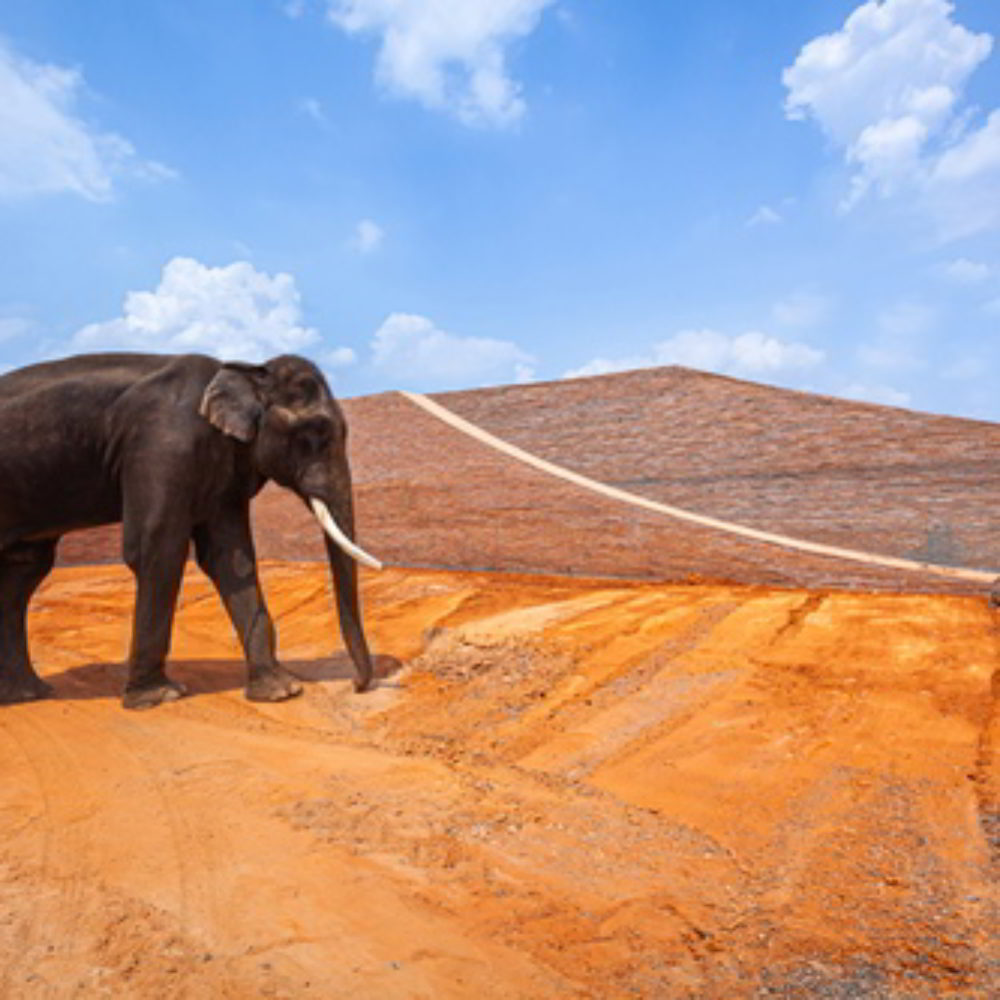Bulgari verleiht seinem Geschäft in Shanghai ein neues Gesicht: eine grün-glühende Fassade. Wie ein jadegleiches Geschmeide macht es der traditionsreichen Luxusmarke alle Ehre und ist dabei überraschend nachhaltig
7. Januar 2022 | Özlem Özdemir
B
ulgari ist ein Luxusschmuckhersteller mit weltweit verstreuten exklusiven Filialen. Einer dieser Flagship-Stores befindet sich im Shanghai Plaza 66, ein beliebtes Einkaufszentrum der chinesischen Metropole. Cartier, Chanel, Dior und viele andere stehen nebeneinander und wetteifern mit ihren Toren, locken Flaneure und Einkaufslustige von den Straßen. Seit 2021 stiehlt Bulgari den Nachbarn die Show. Seine Strategie: eine neue Fassade von MVRDV.
Das niederländische Architekturbüro MVRDV liebt das Innovative und das Gewitzte. Und Fassaden sind ihr Aushängeschild dafür. Ablesbar im wahrsten Sinne des Wortes ist das an einem ihrer Projekte in Deutschland, WERK12. Der öffentliche Bau verblüfft mit einer Gebäudehülle voller geschosshoher Buchstaben. (Die comicartigen Ausrufe wie „ah“ und „oh“ zeugen von einem cleveren Humor, der weiß wie man Architektur populär macht.) Es ist unübersehbar: In Sachen urbane Attraktionen ist das Büro gut trainiert. Und besonders in der Modebranche sind Flagship-Stores in Art von MVRDV en vogue. Für Hermès etwa zauberte das Büro für einen bestehenden Altbau in Amsterdam eine durchsichtige Fassade aus Glasziegeln. Sie gaben ihm den wohlverdienten Namen Crystal Houses. Es geht dabei aber auch um ökologische Belange. So sind alle Glasbauteile von Crystal Houses vollständig recycelbar. (Das zeigte sich bereits bei ihrer Entstehung: Wenn einige Ziegelsteine nicht perfekt waren, konnte man sie einschmelzen und neu formen.)
Auch Bulgari Shanghai glänzt in Sachen Nachhaltigkeit und ist das aktuellste MVRDV-Novum. Dazu muss man wissen: Es ist schon die dritte Flagship-Store-Fassade in der Partnerschaft von MVRDV mit der italienischen Marke. Wie stellt sie sich also diesmal dar?
Zunächst ein Überblick: Die überwiegend grüne Fassade weist auf Straßenebene nur drei Öffnungen auf. Der obere fensterfreie Bereich ist ein durchgehender Schirm aus transluzentem Glas. Der Aufbau ist demnach zweigeteilt: Zuunterst betont eine große Tür mit zwei Flügeln aus durchsichtigem Glas die Mitte. Diesen Eingang flankiert jeweils eine Vitrine von ähnlichem, nur kleinerem Format. Alle drei Elemente sind umrahmt von schmuckartigen Fenstergesimsen aus Messing und Glas. Damit setzen sie sich von der beigen Wandoberfläche ab. Das Glas dieser einrahmenden Portale fungiert wie ein Accessoire und ist von einem leicht melierten Grün. Die Eingangszone schließt ab mit einem gebäudebreiten flachen Kanapee. Oberhalb davon macht sich das ornamenthafte Portalmotiv selbstständig. Befreit von ihrer Funktion als Gesims verwandelt es sich in massive Linien aus Messing, die sich verschachteln und überlagern. Das Gebilde ist von gleichbleibender Tiefe und hat etwas von einem Labyrinth, einem Gewebe, einer Zellenstruktur (wie sie etwa bei Emaillierungen vorkommt). Die symmetrische Grafik erinnert aber vor allem an Art déco, ein Stil, der sowohl das Bulgari-Geschäft von 1905 in Rom (Via dei Condotti 10) als auch die Architekturgeschichte von Shanghai prägt. Ebenso unverkennbar ist die Nähe zur chinesisch-orientalischen Ornamentik und Kultur, Letztere durch die farbliche Anspielung auf Jade, dem Stein, der für die Chinesen voller Bedeutung ist. (Auch wenn Jade in unterschiedlichsten Farben vorkommt, Jadegrün gilt als besonders charakteristisch.)
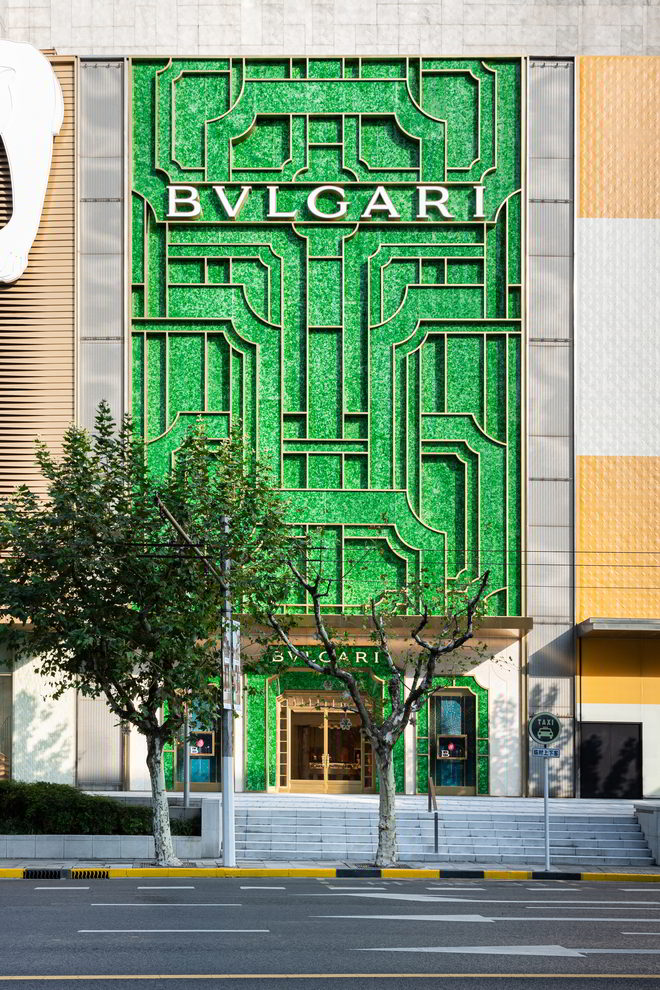
Von Glücksbringer bis zur Mumifizierung: Jade ist begehrt. Aber das Architekturbüro kombiniert das steinern wirkende Fassadenglas mit goldfarbener Messingverzierung für einen ganz bestimmten Zweck; erst durch das Duo beider Materialien kommt es zur entscheidenden Assoziation, zum Eindruck von Edelsteinschmuck. Damit signalisiert das Geschäft nach außen hin, was es im Innern zu bieten hat.
Die Fassade von Bulgari führt vor, was dekorative Kunst oder Kunsthandwerk und damit auch das Metier der Juweliere ist – und was es sein kann. Zum Beispiel hat es Architekturpotenzial. Bemerkenswert ist außerdem, dass MVRDV – anders als ihre Bulgari-Fassaden in Bangkok und Kuala Lumpur – den Entwurf für Shanghai symmetrisch aufbaut. Die Fassade strahlt dadurch eine größere Ruhe und Erhabenheit aus. Eine entsprechende Pointe sind die Portal-Motive, die eine deutliche Sprache sprechen, die Sprache der Tempel und Paläste.
Tritt man näher an die Fassade heran, ahnen selbst Laien: Das Glas ist kein herkömmliches. Es handelt sich um gesintertes1 grünes Glas mit transluzenter Oberfläche. Bei Beleuchtung erstrahlt die Struktur des Glases und verrät, dass es ein Recyclingprodukt ist. MVRDV nutzt übrig gebliebene Champagner-, Bier- und andere Glasflaschen. Im Konglomerat verlieren die Scherben ihre scharfen Kanten; die verschiedenen Glassorten überlagern sich und gehen ineinander über. (Hersteller ist die deutsche Glaskeramik-Firma Magna.) Laut Büro steht das Projekt für das Ziel, Geschäfte zu entwerfen, die zu 100 % aus Materialien der Kreislaufwirtschaft bestehen. (Dem umweltfreundlichen Anspruch entspricht auch die Hintergrundbeleuchtung; sie verbraucht die geringstmögliche Energiemenge, zumindest weniger als die Hälfte der Energie einer vergleichbaren Installation.)

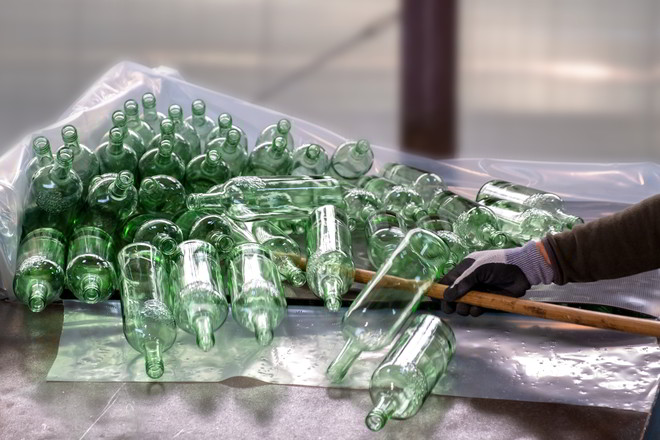
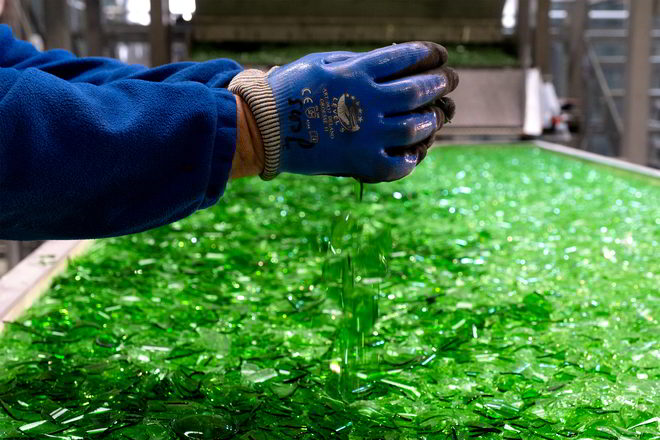

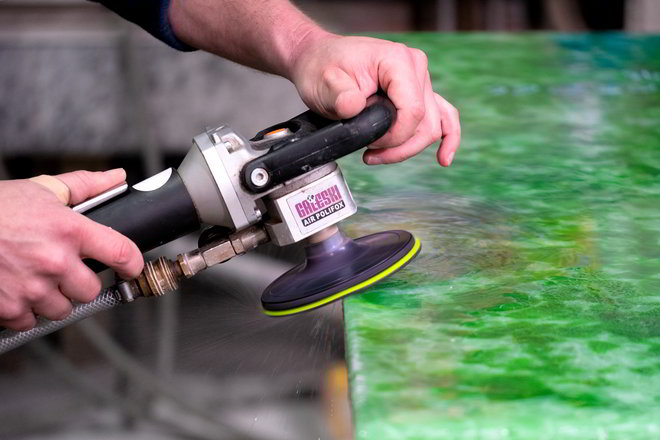
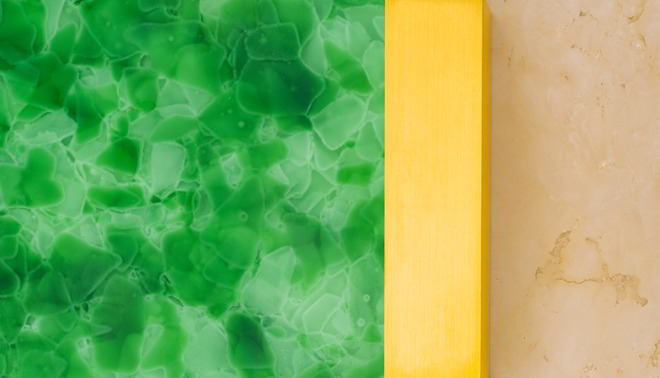
Materialexperimente sind ein wichtiger Faktor bei MVRDV. Die „Spielfreude“ beherrscht aber auch den Prozess der Formfindung, den Entwurf. MVRDV ist offen für unverhoffte Inspirationen. Um mit einem letzten Beispiel auszuholen, sei verwiesen auf ihr Projekt Depot Boijmans Van Beuningen. Als man eines Tages den Entwurf für das Kunstdepot diskutierte, mit einem Umgebungsmodell auf dem Tisch, lag es plötzlich sehr nahe, die Büro-Zuckerdose auf das Grundstück zu setzen und als möglichen Konzept-Kandidaten zu erproben. Der Rest ist Geschichte: Der alltägliche Gebrauchsgegenstand stieg auf zu dem Depot von Rotterdam.
Zurück zum Standort Shanghai: Um die Bulgari-Fassade besser zu verstehen, muss man ihre unmittelbare Umgebung beachten. Das Geschäft im Plaza 66 steht in der Nanjing Road, eine der quirligsten Einkaufsstraßen weltweit. Bei ihren allabendlichen Night Walks werden die Menschen von farbigen und dynamischen Illuminationen bombardiert – Gebäude verwandeln sich in Vehikel für Licht. Die Bulgari-Fassade hält bei diesem „flashigen“ Reigen mit, springt aber doch aus der Reihe. Hier steht nicht der Lichteffekt im Mittelpunkt. Der eigentliche Star ist das Material, das zum Objekt wird. Und die Fassade wird zum eingefassten Stein, der von innen heraus erglüht. (Die Hintergrundbeleuchtung bleibt dabei, auch im übertragenen Sinne, im Hintergrund.)


Die Fassade als Objekt an sich, als etwas Unabhängiges vom Bauwerk: Das ist es, was das Shanghaier Bulgari-Geschäft hervorhebt. Abgesehen von Schmuck erinnert dieses Objekt jedoch auch – gerade bei Nacht – an einen Lampenschirm. Und von dieser Assoziation ist der nächste Schritt nicht weit zu Louis Comfort Tiffany. Tiffany war ein Glaskünstler des 19. Jahrhunderts, bekannt für seine Leuchten aus gelöteten Glastücken und seinen Vater, dem Inhaber von Tiffany & Co.
Damit kommt man um eines nicht herum: Frühstück bei Tiffany (ein lohnender Exkurs, der zu Bulgari zurückführen wird). Der Filmklassiker, der in New York spielt, hat eine ikonische Szene: Heldin und Held feiern einen verrückten Tag, probieren Sachen aus, die sie noch nie getan haben. Teil dieser Aktion: ein Besuch bei Tiffany in der 5th Avenue. (Gebaut wurde es 1905, interessanterweise im selben Jahr wie das Bulgari in der Via dei Condotti in Rom.) Das Filmpaar hat sogleich einen Plan, den Kauf eines Geschenks – etwas (für sie eigentlich) Unmögliches. Zum Thema Diamanten verkündet Holly Golightly: “I think they’re divine on older women, but they wouldn’t be right for me.” Sie weiß, Paul Varjak, der arme Schriftsteller an ihrer Seite, hat kein volles Portemonnaie und man einigt sich: Es darf nicht teurer sein als zehn Dollar. Eine ernste Herausforderung für den Verkäufer; aber sein Vorschlag in Form eines 14-karätigen Zahnstochers wird als zu unromantisch abgelehnt. Plötzlich entdeckt der Schriftsteller ein unauffälliges Schild auf dem Tresen: „Monogramming, Ten Dollars Extra.“ Der schöpferische Geistesblitz folgt sogleich. Ihm fällt ein, die Snacktüte in seiner Jackentasche beinhaltete eine kleine Prämie, einen billigen Ring. Er holt ihn hervor; der Verkäufer ist gerührt und bewundert die einfache Ware mit würdiger Miene: „Do they really still put prizes in Crackerjack boxes?“ Und er schließt mit den Worten: „That’s good to know. It gives one a feeling of solidarity … a continuity with the past and that sort of thing.”2
Genau zu dieser Sorte gehört auch die Bulgari-Fassade in Shanghai. Sie wurzelt unverkennbar im „altehrwürdigen“ Stil des Art déco des Hauses und ist doch – beim genaueren Hinschauen – auf moderne Art kreativ. Was hier funkelt und glänzt, ist nicht der Edelstein, sondern der Gedanke, ein simples Produkt zu veredeln. Eine komplette Fassade aus Jade wäre tatsächlich „göttlich“, aber es geht auch anders. Der Film mit Audrey Hepburn verhalf dem amerikanischen Juweliergeschäft zur Image-Werbung von emotionaler, aber auch pfiffiger Art. Ähnlich verhält es sich mit dem niederländischen Fassadendesign: Mit dieser Wahl bleibt Bulgari seinem Image als Traditionsmarke treu; sie bleibt nobel, aber nicht allein im materiellen Sinne. Sie begrüßt das Unkonventionelle und beweist Esprit – eine exquisite Eigenschaft, die selten ist in der funktionsbefrachteten Welt der Architektur. Tradition, so beweist das Projekt, schließt kühne Experimente nicht aus. Mit ihrer Fassade in Shanghai präsentiert Bulgari die Eigenschaften des Glamours und Luxus in einem intelligenten, umweltbewussten und damit zeitgemäßigen Licht. Jade aus Restflaschen herzustellen und wertzuschätzen ist erfrischend. Diese Filiale strahlt mit Selbstbewusstsein aus „Ich bin ein echter Bulgari“. (Und dabei spielt sie – und das ist ein reizvoller Nebeneffekt – mit den Phänomen Mimikry, Imitation und Fake.)
Eine Frage ist am Ende erlaubt: Wäre das Ganze mit all der technischen Raffinesse und suggestiven Ästhetik nicht auch geglückt mit Wasserflaschen pur – statt eines Mix aus Champagner und anderen Sorten? Es wäre konsequenter und vom Erfindergeist des besagten Paul Varjak gewesen, der aus einer Snacktüten-Beigabe ein wahres Kunstwerk erschafft. Es hätte dem High-Society-Elitärismus, der mit Bulgari verbunden ist, etwas „Volksnahes“ verliehen. Es hätte alchemistischer geklungen. Aber Jade aus Wasserflaschen erschien Bulgari wohl doch zu ordinär – oder nicht so prickelnd wie Schaumwein. So oder so, was bleibt ist der Sinn für versteckte Tricks und eine brillante Idee. Und nicht zuletzt steckt in dieser Fassade – dieser kleinen grünen Schwester des Bernsteinzimmers – auch ein Schuss Ironie: Sie gehört zu den seltenen Schmuckstücken von Bulgari, die unverkäuflich sind. ♦
¹ Beim Sintern werden unter Hitze und hohem Druck Ausgangsstoffe vermengt, welche sich ansonsten nur sehr schwer oder gar nicht zu einem neuen Werkstoff verbinden lassen.
² https://www.dailyscript.com/scripts/BreakfastatTiffany%27s.pdf; letzter Zugriff 7.1.2021
Bulgari Shows Brilliance with Jade à la MVRDV
Bulgari lends a new face to its shop in Shanghai: a green-glowing façade. Like a jade-like jewel, it does honour to the tradition-steeped luxury brand and, at the same time, it is surprisingly sustainable.
Bulgari is a luxury jewellery manufacturer with exclusive shops scattered around the world. One of these flagship stores is located at Shanghai Plaza 66, a popular shopping centre in the Chinese metropolis. Cartier, Chanel, Dior and many others stand side by side, vying with their gates, luring strollers and shoppers from the streets. As of 2021, Bulgari is stealing the show from its neighbours. Its strategy: a new façade of MVRDV.
The Dutch architecture firm MVRDV loves the innovative and the witty. And façades are their poster child for this. One of their projects in Germany, WERK12, reveals this – literally. The public building amazes with a building envelope full of storey-high letters. (The comic-like exclamations like „ah“ and „oh“ display a clever sense of humour that knows how to popularize architecture). It is unmistakable: The office is well-trained in urban attractions. And particularly in the fashion industry, MVRDV-style flagship stores are en vogue. For Hermès, for example, the office conjured up a transparent façade of glass bricks for an existing old building in Amsterdam. They gave it the well-deserved name Crystal Houses. But it is also about ecological concerns. For example, every glass component of Crystal Houses is fully recyclable. (This was already evident during its construction: If some bricks were not perfect, they could be melted down and reshaped).
Bulgari Shanghai, too, shines in matters of sustainability. It is the latest MVRDV novelty. You have to know: This is the third flagship store facade in MVRDV’s partnership with the Italian brand. So how does it present itself this time?
First, an overview: At street level, the predominantly green façade has only three openings. The upper window-free area is a continuous screen of opaque glass. Thus, the structure divides itself into two parts: At the bottom, a large door with two wings of transparent glass emphasizes the centre. This entrance is flanked on each side by a vitrine of a similar, only smaller format. All three elements get a frame by ornamental window cornices made of brass and glass, setting them apart from the beige wall surface. These framing portals, made of a slightly mottled green glass, act like an accessory. The entrance zone ends with a flat canopy as wide as the building. Above it, the ornamental portal motif becomes autonomous. Freed from its function as a cornice, it transforms into solid lines of brass that interlock and overlap. This formation is of constant depth and has something of a labyrinth, a fabric, a cell structure (such as occurs in enamelling). The symmetrical graphics, however, are above all reminiscent of Art Deco. This style left its mark on both the Bulgari shop of 1905 in Rome (Via dei Condotti 10) and the architectural history of Shanghai. Equally distinctive is the proximity to chinese and oriental ornamentation and culture, the latter through the colourful allusion to jade, a stone full of meaning for the Chinese. (Even though jade occurs in many varieties of colours, jade green is considered particularly characteristic.)
From mojo to mummification: Jade is highly coveted. But the architectural firm combines the stone-like façade glass with gold-coloured brass ornamentation for a specific purpose; it is only through the duo of both materials that the deciding association, the impression of gemstone jewellery, occurs. In this way, the shop signals to the outside what it has to offer within.
The Bulgari façade demonstrates what decorative art or craft, and thus the jewellers‘ profession, is – and what it can be. For example, it has architectural potential. It is also remarkable that MVRDV – unlike their Bulgari façades in Bangkok and Kuala Lumpur – builds the design for Shanghai symmetrically. The façade thus radiates calm and grandeur. A corresponding punch line is the portal motif that speaks a clear language, the language of temples and palaces.
When you get closer to the façade, even the laymen can guess that the glass is not conventional. It is sintered1 green glass with a translucent surface. When illuminated, the structure of the glass gleams and reveals that it is a recycled product. MVRDV uses leftover champagne, beer and other glass bottles. In the conglomerate, the shards lose their sharp edges; the different types of glass overlap and blend into each other. (The manufacturer is the German glass-ceramics company Magna.) According to the office, this project represents their aim to design shops made of 100 % circular economy materials. (The backlighting also meets the environmentally friendly requirement; it consumes the lowest possible amount of energy, at least less than half the energy of a comparable installation.)
Material experiments are an essential factor at MVRDV. But the „joy of play“ also dominates the form-finding process, the design. MVRDV is open to unexpected inspirations. To take one last example, let’s refer to their project Depot Boijmans Van Beuningen. One day, when they were discussing the design for the art depot, with a model of the surroundings on the table, it suddenly suggested itself to put the office sugar bowl on the site and test it as a possible concept candidate. The rest is history: the everyday utilitarian object rose to become the Depot of Rotterdam.
Back to its Shanghai location, one must consider the Bulgari façades immediate surroundings for a better understanding. The Plaza 66 shop is on Nanjing Road, one of the world’s most bustling shopping streets. On their daily Night Walks, people experience a bombardment of colourful and dynamic illuminations – buildings undergo a transformation into vehicles for light. The Bulgari façade keeps up with this „flashy“ show yet stands out from the crowd. The focus here is not on the lighting effect. Instead, the real star is the material, which becomes the object. And the façade turns into a framed stone that glows from within. (The background lighting remains, also in a figurative sense, in the background.)
The façade as a material-object in itself, as something separate from the building: That is what distinguishes Shanghai’s Bulgari shop. Apart from jewellery, however, this object is also reminiscent of a lampshade – especially at night. And from this association, the next step is not far from Louis Comfort Tiffany. Tiffany was a glass artist of the 19th century, known for his lamps made of soldered glass pieces and his father, the owner of Tiffany & Co.
With that, there’s no getting around one thing: Breakfast at Tiffany’s (a worthwhile digression that will lead back to Bulgari). The classic film, set in New York, has an iconic scene: Heroine and hero celebrate a crazy day, trying things they’ve never done before. Part of this action: a visit to Tiffany’s on 5th Avenue. (It was built in 1905, interestingly enough, in the same year as the Bulgari in Via dei Condotti in Rome). The film couple immediately has a plan, the purchase of a gift – something that is (for them, in fact) impossible. On the subject of diamonds, Holly Golightly proclaims: „I think they’re divine on older women, but they wouldn’t be right for me.“ She knows that Paul Varjak, the poor writer at her side, does not have a full wallet, and they agree: It must not be more than ten dollars. That is a serious challenge for the salesman. But his proposal in the form of a 14-carat toothpick is rejected as too unromantic. Suddenly, the writer spots an inconspicuous sign on the counter: „Monogramming, Ten Dollars Extra.“ The creative flash of inspiration follows immediately. He remembers the snack bag in his jacket pocket contained a small bonus, a cheap ring. He pulls it out; the salesman is touched and admires the simple commodity with a dignified expression: „Do they really still put prizes in Crackerjack boxes?“ And he concludes with the words: „That’s good to know. It gives one a feeling of solidarity … a continuity with the past and that sort of thing.“2
The Bulgari façade in Shanghai is precisely of this kind. It is rooted in the „time-honoured“ style of the house’s Art Deco and yet – on closer inspection – is creative in a modern way. What sparkles and shines here is not the gemstone but the deliberation of refining a simple product. A complete façade made of jade would indeed be „divine“, but there are other ways, too. The film with Audrey Hepburn helped the American jewellery business to create image advertising of an emotional but also canny kind. Similarly, the Dutch façade design: With this choice, Bulgari remains true to its image as a traditional brand; it remains noble, but not only in the material sense. It welcomes the unconventional and demonstrates esprit – an exquisite quality, rare in the function-laden world of architecture. Tradition, as the project proves, does not exclude bold experiments. With its Shanghai façade, Bulgari presents the qualities of glamour and luxury in an intelligent, environmentally conscious and thus contemporary light. Making and valuing jade from leftover bottles is refreshing. This shop radiates „I am a real Bulgari“ with confidence. (And in doing so – and this is a delightful side effect – it plays with the phenomena of mimicry, imitation and fake.)
One final question should be allowed: Wouldn’t the whole thing, with all its technical finesse and suggestive aesthetics, also have been successful using water bottles alone – instead of a mix of champagne and other varieties? It would have been more consistent and of the inventive spirit of said Paul Varjak, who creates a real piece of art out of a snack bag addition. It would have given the high-society elitism linked to Bulgari something in touch with the “simple people”. It would have sounded more alchemical. But jade from water bottles probably seemed too vulgar to Bulgari – or not as tingly as sparkling wine. Either way, what remains is a sense of hidden tricks and a brilliant idea. And last but not least, this façade – this little green sister of the Amber Room – also contains a dash of irony: It belongs to the rare pieces of Bulgari jewellery that are not for sale.
TRANSLATION BY ÖZLEM ÖZDEMIR
1 During sintering, raw materials, which are otherwise very difficult or impossible to combine into new materials, are mixed under heat and high pressure.
2 https://www.dailyscript.com/scripts/BreakfastatTiffany%27s.pdf; last access date 7.1.2021





